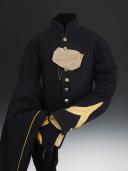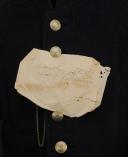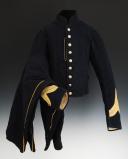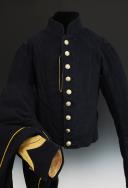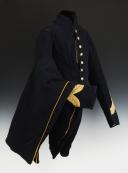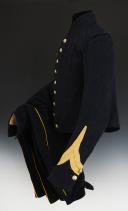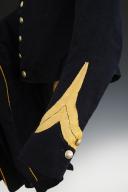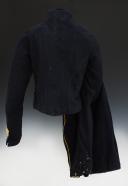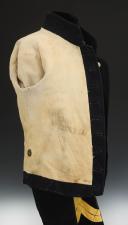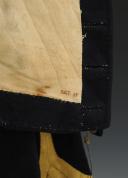
UNIFORM OF PAUL COMTE de SAISY de KERAMPUIL, SERGEANT IN THE FRANCO-BELGIAN SKIRT BATTALION, Second Empire, June 29, 1860 - September 18, 1860. 27923
Sold out
UNIFORM OF PAUL COMTE de SAISY de KERAMPUIL, SERGEANT IN THE FRANCO-BELGIAN SKIRT BATTALION, garment worn in Castelfitardo, Second Empire, June 29, 1860 - September 18, 1860. 27923
Overcoat entirely in dark blue, almost black cloth, closing straight at the front with nine buttonholes with polished pewter buttons mounted on pewter, stamped with a hunting horn (D 1.8 cm) . Collar without ornament. Bottom of the sleeves trimmed with two daffodil braids forming a point in the middle, trimmed with two uniform buttons on the outside. Epaulette loop in dark blue cloth. White canvas lining, small handwritten ink marking “O.G.T. 55”.
Trousers in dark blue, almost black cloth with daffodil side piping, closing with a straight fly with four horn buttons. On the waist belt on each side are two buttons at the front and one button at the back to attach the suspenders. White canvas waist belt lining with “55” size marking.
Paper label accompanying this handwritten uniform “garment worn by O… in Castelfitardo”.
France.
Second Empire, June 29, 1860 - September 18, 1860.
In a perfect state.
ORIGIN :
Uniform from direct lineal descendants, never in a private collection until now. Count Hervé de Saisy de Kerampuil, lieutenant of Louveterie, knight of the Order of Agricultural Merit, born en janvier 1922, died January 31, 2019, Madame Marguerite de Saisy de Kerampuil died September 8, 2023.
LA FAMILLE de SAISY de KERAMPUIL, UNE FAMILLE LIÉE AUX ZOUAVES PONTIFICAUX :
PAUL Césaire Emmanuel Marie Constantin comte de SAISY de KERAMPUIL, né à Kersaint-Éloy (Côtes du Nord) le 29 février 1830. C'est un soldat qui va gravir tous les grades de sergent à celui de lieutenant-colonel ! C'est l'un des quatre chefs de bataillon des zouaves pontificaux, à Rome, de 1868 à 1870.
Engagé aux tirailleurs pontificaux franco-belges à Rome le 29 juin 1860, il sert avec le grade de sergent à Castelfidaro, le 18 septembre 1860, il est nommé sous-lieutenant le 1er octobre 1860. Affecté aux Zouaves Pontificaux, le 1er janvier 1861, il prend le grade de lieutenant le 19 mars 1861, puis celui de capitaine le 18 juin 1861, et de chef de bataillon le 27 décembre 1868.
Au moment de la guerre, il est nommé commandant dans le garde mobile du Finistère en 1870. Nommé au grade de lieutenant-colonel en 1871 et de chevalier de l'Ordre de la Légion d’honneur en Août 1871. Devenu colonel des mobiles de Guingamp, puis chef de la 4e brigade de la division Cathelineau à l'armée de Bretagne, et, après la guerre, commanda, avec le grade de lieutenant-colonel, le 73e régiment d'infanterie territoriale.
Conseiller général, député du Finistère (1885-1889), et président du comité agricole de Carhaix, il fut élu sur la liste conservatrice de Finistère aux élections du 4 octobre 1885 ; il prit place à l'union des droites, combattit de ses votes la politique scolaire et coloniale des ministères républicains, et se prononça, dans la dernière session, contre le rétablissement du scrutin d'arrondissement, pour l'ajournement indéfini de la révision de la Constitution, contre les poursuites contre trois députés membres de la Ligue des patriotes, contre le projet de loi Lisbonne restrictif de la liberté de la presse, contre les poursuites contre le général Boulanger.
Paul de Saisy ne se représenta pas en 1889 et se consacra alors à la mairie de Plouguer.
Il décède le 26 avril 1894 à Rennes à l'âge de 65 ans, Inhumé le 1er mai 1894 - Cimetière Carhaix-Plouguer, Finistère. The tomb of the Saisy de Kerampuil family is located in front of the church.
Campaigns: Mobile column “Marittima and Campagna” in 1860. Affair of Ponte Corese, 1861. Campaign of 1867. Siege of Rome, 1870. Retreat from Viterbo and siege of Rome. French campaign, as lieutenant-colonel of the Finistère Mobiles.
Orders and decorations: Knight of the Order of PIE IX, medal of Castelfitardo, medal of Mentana and Bene Merenti, knight of the Legion of Honor.
His brother Count HERVÉ de SAISY de KERAMPUIL was born at the castle of Kersaint-Eloy in Glomel (Côtes-du-Nord) on April 5, 1833, second lieutenant since 1861, he is in 1863 and 1864 in the Foreign Regiment, he also stayed several years in Sidi-Bel-Abbès, he participated in the Italian and Mexican campaigns, he retired as captain, enlisted in the Pontifical Zouaves. His action in the Papal States earned him an officer of the order of Saint Gregory the Great. In 1870 he was commander of a mobile battalion, during the siege of Paris, he ensured the protection of Trochu for a time at the head of the mobile battalion of Loudéac (Côtes-du-Nord).
Knight of the Legion of Honor in February 1871.
Deputy, then Senator.
Testimonies from the time speak of him as a 2.04 meter giant “capable of loading a barrel of cider onto a cart alone”.
On September 20, 1860, Hervé de Saisy married Faustina Ténérani in Rome, daughter of Piétro Ténérani, sculptor, general director of the Palaces and Museums of Rome and former Roman senator, who gave him a daughter, Alix, born in Saint-Brieuc (Côtes- du-Nord) on January 8, 1866.
CHARLES de SAISY de KERAMPUIL (cousin), born in Saint-Polde-Léon (Finistère), October 23, 1846. He joined the pontifical zouaves on October 23, 1867. Sergeant on December 20, 1868. Campaign of 1867, siege of Rome in 1870. He returned to France in 1870 at the fall of Rome to take part in the fighting against the Germans, at the age of 24 he was wounded in the battle of Brou on November 25, 1870, he died in the hospital in Châteaudun on December 4, after having had his left leg amputated, shattered by a shell.
XAVIER de SAISY de KERAMPUIL (cousin), born February 2, 1843 in Colombey (Meurthe). He is recorded in the directory as a simple Zouave on January 31, 1861, a member of the eldest branch of the family who, after participating in the 1870 campaign, died the same year in Libourne at the age of 27 as a result of the war. He transferred to the artillery on November 21, 1861.
HISTORY:
The battalion of pontifical Zouaves, created on January 1, 1861 on the model of the Zouave troops of the French army, whose exotic uniform was very popular in the middle of the 19th century, which became a regiment on January 1, 1867, is made up of volunteers, mainly French, Belgians and Dutch, who came to defend the Papal State, whose existence was threatened by the achievement of Italian Unity for the benefit of Piedmont. Its history is correlated with the last decade of the State of the Holy See (1860-1870). The regiment was disbanded on September 21, 1870 following the disappearance of the Papal States.
The creation of the corps of pontifical Zouaves.
In 1860, the fate of the Papal State seemed critical. The Catholic powers lost interest in the question, so the secret chamberlain of Pope Pius IX, Mgr Xavier de Merode, a former soldier who became pro-minister of arms, decided to call on General de Lamoricière to reorganize and command the pontifical army. To increase numbers, Lamoricière resorted to voluntary enlistment and appealed to Catholic states. Belgians and French constitute a battalion of Franco-Belgian riflemen (the largest contingents come from Brittany and Vendée) under the orders of Viscount Louis de Becdelièvre. He personally wants to provide them with the uniform inspired by the Zouaves, and adapted to the Roman heat. Quite poorly received by Lamoricière who has many other more urgent problems, he has the support of Mgr de Merode and the Pope himself; the tirailleurs were therefore called pontifical Zouaves even before the official creation of the corps. The Piedmontese crushed the Pontificals at the battle of Castelfidardo (September 18, 1860) and the Pope's state was reduced to Lazio alone. The disaster caused volunteers to flock to Rome: the battalion of the Pontifical Zouaves was made up of part of the Franco-Belgian riflemen and the Irish from the battalion of Saint-Patrick, to which had been added, before the battle, the few "crusaders" by Henri de Cathelineau.
Joseph-Louis Guérin, a Nantes seminarian, wounded during the fighting, died on October 30, 1860. His grave, in Nantes, became a very popular place of pilgrimage; He was even attributed 35 healing miracles between 1861 and 1864.
Until 1864, the Zouaves numbered between 300 and 600 men, then the strength rose to 1,500 men then 1,800 before reaching the maximum of 3,200 men shortly before the fall of Rome.
Between 1861 and 1870 the papal army increased its numbers, reaching 18,000 men, including 11,000 volunteers (among them 3,000 French, nearly 40% of whom came from Brittany or Vendée).
On April 11, 1866, a circular from Marshal Randon authorized the creation of the Legion of Antibes which, alongside the Papal Zouaves, provided manpower to the Pontifical army, especially soldiers of French nationality.
Between 1861 and 1870, there were more than 10,000 new recruits from 25 different nationalities. The most numerous are the Dutch, then the French and the Belgians but there are also Swiss, Germans, Italians, Canadians and even Americans. Out of 170 officers, there are 111 French and 25 Belgians. Their chaplain is Mgr Jules Daniel, a native of Nantes, assisted by two Belgians, Mgr Sacré and Mgr de Woelmont.
One of the best-known recruits is John Surratt (1844-1916), involved in the assassination of Abraham Lincoln in 1865: having fled to Europe, he served for some time in the ninth company of Papal Zouaves, under the name of John Watson2.
More than a third of the French workforce comes from the departments making up the current regions of Brittany and Pays de la Loire. This influx masks the significant contributions from the North, the Nîmes region, and the south of the Massif Central. If Dutch-speaking Belgians and Dutch are often of working-class origin, the nobility is well represented among the French and the French-speaking Belgian volunteers. The Duke of La Rochefoucauld-Doudeauville and his brother, the Duke of La Rochefoucauld-Bisaccia, financially supported the company by fully equipping 1,000 men. Their common point is their attachment to the Roman Catholic Church: their fight is seen as a crusade to defend the capital of Catholicism and the freedom of the Pope against the revolutionary Garibaldi and King Victor-Emmanuel II. Their religious commitment is often inseparable from their political commitment: many French people claim to be legitimist.
Overcoat entirely in dark blue, almost black cloth, closing straight at the front with nine buttonholes with polished pewter buttons mounted on pewter, stamped with a hunting horn (D 1.8 cm) . Collar without ornament. Bottom of the sleeves trimmed with two daffodil braids forming a point in the middle, trimmed with two uniform buttons on the outside. Epaulette loop in dark blue cloth. White canvas lining, small handwritten ink marking “O.G.T. 55”.
Trousers in dark blue, almost black cloth with daffodil side piping, closing with a straight fly with four horn buttons. On the waist belt on each side are two buttons at the front and one button at the back to attach the suspenders. White canvas waist belt lining with “55” size marking.
Paper label accompanying this handwritten uniform “garment worn by O… in Castelfitardo”.
France.
Second Empire, June 29, 1860 - September 18, 1860.
In a perfect state.
ORIGIN :
Uniform from direct lineal descendants, never in a private collection until now. Count Hervé de Saisy de Kerampuil, lieutenant of Louveterie, knight of the Order of Agricultural Merit, born en janvier 1922, died January 31, 2019, Madame Marguerite de Saisy de Kerampuil died September 8, 2023.
LA FAMILLE de SAISY de KERAMPUIL, UNE FAMILLE LIÉE AUX ZOUAVES PONTIFICAUX :
PAUL Césaire Emmanuel Marie Constantin comte de SAISY de KERAMPUIL, né à Kersaint-Éloy (Côtes du Nord) le 29 février 1830. C'est un soldat qui va gravir tous les grades de sergent à celui de lieutenant-colonel ! C'est l'un des quatre chefs de bataillon des zouaves pontificaux, à Rome, de 1868 à 1870.
Engagé aux tirailleurs pontificaux franco-belges à Rome le 29 juin 1860, il sert avec le grade de sergent à Castelfidaro, le 18 septembre 1860, il est nommé sous-lieutenant le 1er octobre 1860. Affecté aux Zouaves Pontificaux, le 1er janvier 1861, il prend le grade de lieutenant le 19 mars 1861, puis celui de capitaine le 18 juin 1861, et de chef de bataillon le 27 décembre 1868.
Au moment de la guerre, il est nommé commandant dans le garde mobile du Finistère en 1870. Nommé au grade de lieutenant-colonel en 1871 et de chevalier de l'Ordre de la Légion d’honneur en Août 1871. Devenu colonel des mobiles de Guingamp, puis chef de la 4e brigade de la division Cathelineau à l'armée de Bretagne, et, après la guerre, commanda, avec le grade de lieutenant-colonel, le 73e régiment d'infanterie territoriale.
Conseiller général, député du Finistère (1885-1889), et président du comité agricole de Carhaix, il fut élu sur la liste conservatrice de Finistère aux élections du 4 octobre 1885 ; il prit place à l'union des droites, combattit de ses votes la politique scolaire et coloniale des ministères républicains, et se prononça, dans la dernière session, contre le rétablissement du scrutin d'arrondissement, pour l'ajournement indéfini de la révision de la Constitution, contre les poursuites contre trois députés membres de la Ligue des patriotes, contre le projet de loi Lisbonne restrictif de la liberté de la presse, contre les poursuites contre le général Boulanger.
Paul de Saisy ne se représenta pas en 1889 et se consacra alors à la mairie de Plouguer.
Il décède le 26 avril 1894 à Rennes à l'âge de 65 ans, Inhumé le 1er mai 1894 - Cimetière Carhaix-Plouguer, Finistère. The tomb of the Saisy de Kerampuil family is located in front of the church.
Campaigns: Mobile column “Marittima and Campagna” in 1860. Affair of Ponte Corese, 1861. Campaign of 1867. Siege of Rome, 1870. Retreat from Viterbo and siege of Rome. French campaign, as lieutenant-colonel of the Finistère Mobiles.
Orders and decorations: Knight of the Order of PIE IX, medal of Castelfitardo, medal of Mentana and Bene Merenti, knight of the Legion of Honor.
His brother Count HERVÉ de SAISY de KERAMPUIL was born at the castle of Kersaint-Eloy in Glomel (Côtes-du-Nord) on April 5, 1833, second lieutenant since 1861, he is in 1863 and 1864 in the Foreign Regiment, he also stayed several years in Sidi-Bel-Abbès, he participated in the Italian and Mexican campaigns, he retired as captain, enlisted in the Pontifical Zouaves. His action in the Papal States earned him an officer of the order of Saint Gregory the Great. In 1870 he was commander of a mobile battalion, during the siege of Paris, he ensured the protection of Trochu for a time at the head of the mobile battalion of Loudéac (Côtes-du-Nord).
Knight of the Legion of Honor in February 1871.
Deputy, then Senator.
Testimonies from the time speak of him as a 2.04 meter giant “capable of loading a barrel of cider onto a cart alone”.
On September 20, 1860, Hervé de Saisy married Faustina Ténérani in Rome, daughter of Piétro Ténérani, sculptor, general director of the Palaces and Museums of Rome and former Roman senator, who gave him a daughter, Alix, born in Saint-Brieuc (Côtes- du-Nord) on January 8, 1866.
CHARLES de SAISY de KERAMPUIL (cousin), born in Saint-Polde-Léon (Finistère), October 23, 1846. He joined the pontifical zouaves on October 23, 1867. Sergeant on December 20, 1868. Campaign of 1867, siege of Rome in 1870. He returned to France in 1870 at the fall of Rome to take part in the fighting against the Germans, at the age of 24 he was wounded in the battle of Brou on November 25, 1870, he died in the hospital in Châteaudun on December 4, after having had his left leg amputated, shattered by a shell.
XAVIER de SAISY de KERAMPUIL (cousin), born February 2, 1843 in Colombey (Meurthe). He is recorded in the directory as a simple Zouave on January 31, 1861, a member of the eldest branch of the family who, after participating in the 1870 campaign, died the same year in Libourne at the age of 27 as a result of the war. He transferred to the artillery on November 21, 1861.
HISTORY:
The battalion of pontifical Zouaves, created on January 1, 1861 on the model of the Zouave troops of the French army, whose exotic uniform was very popular in the middle of the 19th century, which became a regiment on January 1, 1867, is made up of volunteers, mainly French, Belgians and Dutch, who came to defend the Papal State, whose existence was threatened by the achievement of Italian Unity for the benefit of Piedmont. Its history is correlated with the last decade of the State of the Holy See (1860-1870). The regiment was disbanded on September 21, 1870 following the disappearance of the Papal States.
The creation of the corps of pontifical Zouaves.
In 1860, the fate of the Papal State seemed critical. The Catholic powers lost interest in the question, so the secret chamberlain of Pope Pius IX, Mgr Xavier de Merode, a former soldier who became pro-minister of arms, decided to call on General de Lamoricière to reorganize and command the pontifical army. To increase numbers, Lamoricière resorted to voluntary enlistment and appealed to Catholic states. Belgians and French constitute a battalion of Franco-Belgian riflemen (the largest contingents come from Brittany and Vendée) under the orders of Viscount Louis de Becdelièvre. He personally wants to provide them with the uniform inspired by the Zouaves, and adapted to the Roman heat. Quite poorly received by Lamoricière who has many other more urgent problems, he has the support of Mgr de Merode and the Pope himself; the tirailleurs were therefore called pontifical Zouaves even before the official creation of the corps. The Piedmontese crushed the Pontificals at the battle of Castelfidardo (September 18, 1860) and the Pope's state was reduced to Lazio alone. The disaster caused volunteers to flock to Rome: the battalion of the Pontifical Zouaves was made up of part of the Franco-Belgian riflemen and the Irish from the battalion of Saint-Patrick, to which had been added, before the battle, the few "crusaders" by Henri de Cathelineau.
Joseph-Louis Guérin, a Nantes seminarian, wounded during the fighting, died on October 30, 1860. His grave, in Nantes, became a very popular place of pilgrimage; He was even attributed 35 healing miracles between 1861 and 1864.
Until 1864, the Zouaves numbered between 300 and 600 men, then the strength rose to 1,500 men then 1,800 before reaching the maximum of 3,200 men shortly before the fall of Rome.
Between 1861 and 1870 the papal army increased its numbers, reaching 18,000 men, including 11,000 volunteers (among them 3,000 French, nearly 40% of whom came from Brittany or Vendée).
On April 11, 1866, a circular from Marshal Randon authorized the creation of the Legion of Antibes which, alongside the Papal Zouaves, provided manpower to the Pontifical army, especially soldiers of French nationality.
Between 1861 and 1870, there were more than 10,000 new recruits from 25 different nationalities. The most numerous are the Dutch, then the French and the Belgians but there are also Swiss, Germans, Italians, Canadians and even Americans. Out of 170 officers, there are 111 French and 25 Belgians. Their chaplain is Mgr Jules Daniel, a native of Nantes, assisted by two Belgians, Mgr Sacré and Mgr de Woelmont.
One of the best-known recruits is John Surratt (1844-1916), involved in the assassination of Abraham Lincoln in 1865: having fled to Europe, he served for some time in the ninth company of Papal Zouaves, under the name of John Watson2.
More than a third of the French workforce comes from the departments making up the current regions of Brittany and Pays de la Loire. This influx masks the significant contributions from the North, the Nîmes region, and the south of the Massif Central. If Dutch-speaking Belgians and Dutch are often of working-class origin, the nobility is well represented among the French and the French-speaking Belgian volunteers. The Duke of La Rochefoucauld-Doudeauville and his brother, the Duke of La Rochefoucauld-Bisaccia, financially supported the company by fully equipping 1,000 men. Their common point is their attachment to the Roman Catholic Church: their fight is seen as a crusade to defend the capital of Catholicism and the freedom of the Pope against the revolutionary Garibaldi and King Victor-Emmanuel II. Their religious commitment is often inseparable from their political commitment: many French people claim to be legitimist.
Reference :
27923
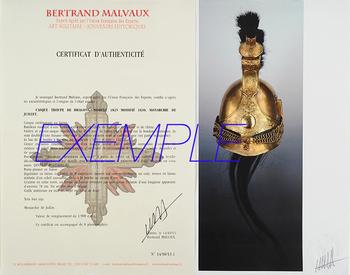
Next update Friday, april 4th at 1:30 PM
FOR ALL PURCHASES, PAYMENT IN MULTIPLE CHECKS POSSIBLE
bertrand.malvaux@wanadoo.fr 06 07 75 74 63
An authenticity certificate of the item including the description published on the site, the period, the sale price, accompanied by one or more color photographs is automatically provided for any item priced over 130 euros. Below this price, each certificate is charged 5 euros.
Only items sold by me are subject to an authenticity certificate, I do not provide any expert reports for items sold by third parties (colleagues or collectors).
